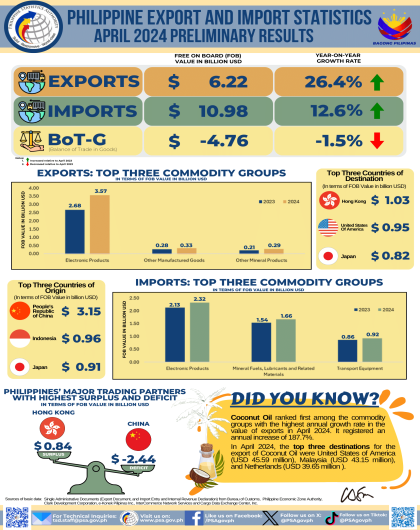Highlights of the Philippine Export and Import Statistics April 2024 (Preliminary)
January to September total trade stands at $54.219 billion
Total external trade in goods for January to September 2003 amounted to $54.219 billion or 2.6 percent higher than $52.827 billion during the same period last year. The bill for foreign-made merchandise went up by 4.8 percent to $27.952 billion from $26.669 billion. Similarly, exports recorded a year-on-year growth rate of 0.4 percent to an aggregate dollar revenue of $26.267 billion from $26.158 billion a year ago. Balance of trade of goods (BOT-G) deficit for the Philippines reached $1.686 billion, higher than last years value of $511 million.
Figure 1A. Philippine Trade Performance in January - September : 2002 and 2003
(F.O.B. Value in Million US Dollar)
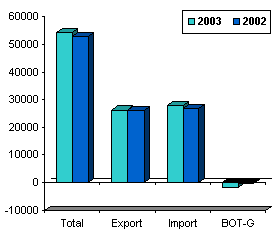
Figure 1B. Philippine Trade Performance: September: 2002 and 2003
(F.O.B. Value in Million US Dollar)
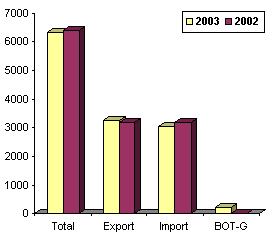
September imports down by 4.5 percent
Total merchandise trade for September 2003 declined by 1.1 percent to $6.309 billion from $6.381 billion during the same period a year ago. Dollar-inflow generated by exports amounted to $3.264 billion, or 2.3 percent higher than last years $3.191 billion. On the other hand, expenditures for imported goods fell by 4.5 percent to $3.046 billion from $3.190 billion. The BOT-G surplus for the Philippines was registered at $218 million, compared to last years figure at $2 million.
Electronic products account for 47.0 percent of import bill
Accounting for 47.0 percent of the total aggregate import bill, payments for electronic products amounted to $1.431 billion or 5.9 percent lower than last year's $1.521 billion. Compared to the previous month, dollar-outflow dropped by 3.2 percent from $1.478 billion.
Purchases of mineral fuels, lubricants and related materials ranked second with 9.8 percent share. Expenditures incurred at $297.23 million, registered a 0.5 percent increase over the previous level which stood at $295.85 million.
Industrial machinery and equipment, the third top import reported purchases worth $136.24 million, or a 0.6 percent decline from $137.12 million last year.
Transport equipment accounting for 3.8 percent of the total imports, ranked fourth as foreign bill amounted to $116.29 million, up by 13.2 percent from last year's $102.72 million.
Iron and steel, contributing 2.4 percent to the total bill, was RPs fifth top import for the month with payments placed at $73.89 million or 27.1 percent lower than last years $101.37 million.
Expenditures for telecommunication equipment and electrical machinery, with a 2.4 percent share to the aggregate bill, grew by 19.2 percent to $72.11 million from $60.48 million in September 2002.
Rounding up the list of the top imports for September 2003 were: textile yarn, fabrics, made-up articles and related products, $68.71 million; cereals and cereal preparation,$63.03 million; plastics in primary and non-primary forms, $60.11 million; and feeding stuff for animals (not including unmilled cereals), $50.11 million.
Aggregate payment for the countrys top ten imports for September 2003 amounted to $2.369 billion or 77.8 percent of the total bill.
Figure 2. Philippine Top Imports in September 2002 and 2003
(F.O.B. Value in Million US Dollar)
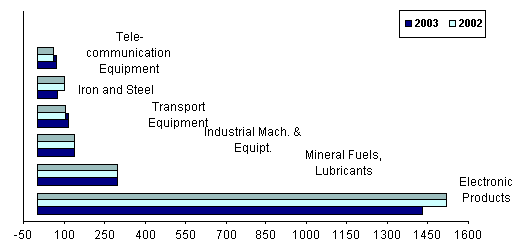
Capital goods account for 42.6 percent of the total import bill
Capital goods comprising 42.6 percent of the aggregate bill went up by 6.6 percent year-on-year to $1.298 billion from $1.217 billion. The biggest share went to telecommunication equipment and electrical machinery with a 23.3 percent share of the total and valued at $708.81 million.
Payments for raw materials and intermediate goods consisting of unprocessed raw materials and semi-processed raw materials accounted for 36.8 percent of the aggregate bill, as importation declined by 13.8 percent to $1.122 billion from last years reported figure at $1.302 billion.
Expenditures for mineral fuels, lubricants and related materials inched up by 0.5 percent to $297.23 million from $295.85 million during the same period of 2002.
Purchases of consumer goods valued at $221.12 million, decreased by 17.2 percent from $267.18 million in September 2002, while special transactions went down by 0.7 percent to $107.0 million from $107.76 million.
Figure 3. Philippine Imports by Major Type of Goods in September: 2002 and 2003
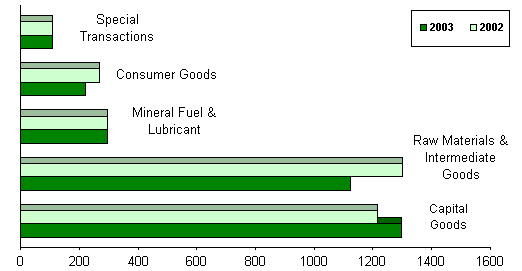
Japan corners 21.5 percent of september import bill
Imports from Japan accounting for 21.5 percent of the total import bill, climbed by 0.8 percent to $653.79 million from $648.30 million during the same period last year. Likewise, exports to Japan, amounted to $489.88 million yielding a two-way trade value of $1.144 billion and a trade deficit for RP placed at $163.92 million.
United States, the countrys second biggest source of imports with a 19.0 percent share, reported shipments valued at $579.99 million against exports amounting to $630.0 million. Total trade amounted to $1.210 billion, with a trade surplus for the Philippines at $50.01 million.
Singapore, followed as RPs third biggest source of imports. With payments worth $197.82 million, imports from Singapore accelerated by 4.8 percent from $188.85 million while revenue from RPs exports reached $224.25 million resulting to a total trade value of $422.07 million and a $26.43 million surplus for RP.
Other major sources of imports for the month of September were: Republic of Korea, $163.12 million; Peoples Republic of China, $158.50 million; Taiwan, $146.16 million;Hong Kong, $133.53 million; Thailand, $120.02 million; Malaysia, $116.92 million; andSaudi Arabia, $104.44 million.
Payments for imports from the top ten sources for the month amounted to $2.374 billion or 78.0 percent of the total.
Figure 4. Philippine Imports by Country in September: 2003
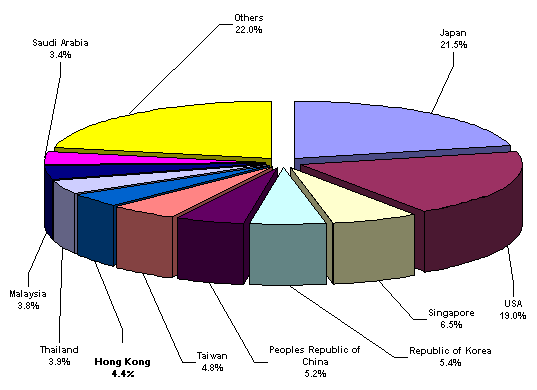
As of press time 109 out of 65,281 export documents and 102 out of 68,974 import documents are still expected from the ports.
Source: National Statistics Office
Manila, Philippines

